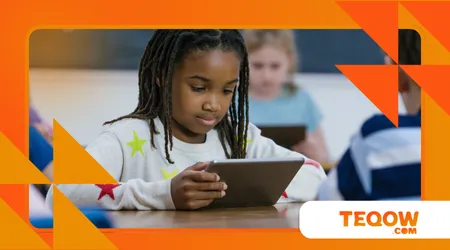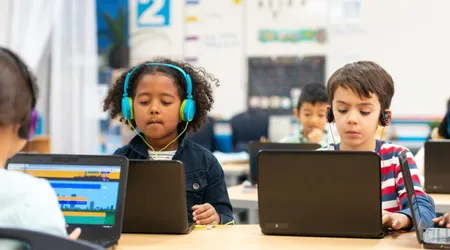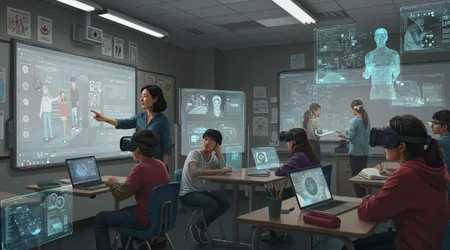How Public Education in Canada Is Adapting to New Technological Demands

Public education in Canada stands at a crossroads, navigating a digital revolution that demands agility, foresight, and innovation.
As classrooms evolve into tech-driven hubs, educators, policymakers, and communities grapple with integrating cutting-edge tools while preserving the human essence of learning.
From AI-powered platforms to virtual reality labs, the landscape is shifting fast faster than some schools can keep up.
Yet, this transformation isn’t just about gadgets; it’s about preparing students for a world where technology shapes every job, interaction, and idea.
How is Canada’s public education system rising to this challenge? This article dives into the strategies, successes, and hurdles, offering a clear-eyed look at a system in flux.
The stakes are high. A 2023 report by the Council of Ministers of Education, Canada (CMEC), noted that 68% of Canadian employers now require digital literacy as a baseline skill.
Schools must deliver not just tech access but fluency in critical thinking amid automation. Rural and urban divides, funding gaps, and teacher training add complexity.
Yet, Canada’s public education is adapting through bold initiatives, from curriculum overhauls to partnerships with tech giants.
This journey is messy but vital, and the nation’s future hinges on getting it right. Let’s explore how public education is rewriting its playbook for 2025’s technological demands.
Curriculum Evolution: Embedding Tech Literacy
Canada’s public education curricula are undergoing a seismic shift to embed digital literacy. Provinces like Ontario have mandated coding in K-12 since 2022.
Students now learn Python alongside poetry, blending logic with creativity. This isn’t just about programming; it’s about problem-solving in a tech-driven world.
Schools aim to produce graduates who can navigate AI tools, not just use them.
Beyond coding, digital citizenship is a priority. British Columbia’s curriculum now includes lessons on data privacy and online ethics.
++ New Provincial Initiatives to Support Indigenous Education and Reconciliation
Students analyze real-world scenarios, like social media misinformation, to build critical thinking.
This approach ensures they’re not just tech-savvy but tech-wise, ready for a world of algorithms.
However, gaps persist. Rural schools often lack resources to implement these changes fully. A teacher in Nunavut shared, “We have the curriculum, but not the computers.”
Closing this divide is critical to ensure equitable tech education across public education systems.

Teacher Training: Equipping Educators for the Digital Age
Educators are the linchpin of this transformation, yet many feel underprepared. Professional development in public education is ramping up to bridge this gap.
Alberta’s government, for example, launched a $12 million initiative in 2024 to train teachers in AI and virtual tools.
Workshops focus on practical skills, like using learning management systems effectively.
Still, time is a barrier. A high school teacher in Manitoba told me, “We’re learning AI on weekends, unpaid.”
Also read: The Role of Digital Literacy in Shaping Tomorrow’s Workforce
Overworked educators need systemic support, not just one-off sessions. Without it, tech integration risks being superficial, undermining public education’s goals.
Innovative solutions are emerging. Ontario’s e-Learning Consortium pairs tech-proficient teachers with novices for mentorship.
This peer-driven model fosters confidence and collaboration, ensuring educators aren’t left behind in the digital race.
Infrastructure Investments: Building the Tech Backbone
Access to technology is non-negotiable, but Canada’s public education faces uneven infrastructure. Urban schools boast high-speed Wi-Fi and 1:1 device programs, while rural ones struggle.
In 2024, the federal government pledged $2 billion to expand broadband in remote areas, targeting schools first.
This investment is bearing fruit. A school in Haida Gwaii now uses cloud-based platforms for real-time collaboration.
Read more: How Canadian Universities Are Adapting to Declining International Student Enrollments
Students there joined a virtual science fair with peers in Toronto, leveling the playing field. Yet, funding must be sustained to maintain this momentum.
Device access also varies. Quebec’s 2023 tablet initiative equipped 80% of secondary students, but maintenance costs loom.
Schools need long-term plans to keep tech current, or risk obsolescence in public education’s digital push.
Partnerships with Industry: Bridging Classroom and Career
Collaboration with tech giants is reshaping public education. Programs like Microsoft’s Education Transformation Framework bring AI tools to classrooms.
In Nova Scotia, students use Azure to analyze environmental data, linking academics to real-world applications. These partnerships spark engagement and career readiness.
Yet, there’s a catch. Overreliance on corporate tools risks data privacy and curriculum bias. A 2024 Toronto District School Board review flagged concerns about student data in third-party platforms.
Schools must balance innovation with oversight to protect students.
Smaller partnerships shine, too. A Vancouver coding bootcamp, partnered with local startups, offers high schoolers internships.
One student, Priya, built an app for food bank logistics, proving public education can foster tangible innovation when aligned with industry.
Equity and Inclusion: Ensuring No Student Is Left Behind

Technology can amplify inequities if not carefully managed. Public education must prioritize access for marginalized groups.
Indigenous communities, for instance, often face tech shortages. A 2024 CMEC initiative delivered 5,000 laptops to First Nations schools, but training lags.
Socioeconomic divides also matter. Low-income students in urban centers like Winnipeg rely on school devices.
When tech fails, they’re cut off. Schools are piloting take-home device programs, but funding is tight, and theft risks persist.
Gender gaps in STEM persist, too. Girls Who Code Canada, active in 15 cities, runs workshops to boost female participation.
A participant, Aisha, designed a health app, showing how targeted programs in public education can close divides.
Emerging Technologies: VR, AI, and Beyond
Classrooms are becoming tech playgrounds. Virtual reality (VR) labs in Alberta let students dissect virtual frogs or explore ancient Rome.
These tools make abstract concepts tangible, boosting engagement. A 2023 study found VR improved retention by 20% in science classes.
AI is another game-changer. Platforms like Century Tech personalize learning, adapting to each student’s pace.
A Montreal school reported a 15% jump in math scores after piloting AI tutors. Yet, high costs limit widespread adoption.
Ethical concerns loom. AI can perpetuate biases if not carefully designed. Schools must teach students to question algorithms, not just use them.
This critical lens is vital for public education to harness emerging tech responsibly.
Student Voice: Empowering the Next Generation
Students aren’t just recipients of tech they’re shaping it. Public education is fostering agency through student-led projects.
In Saskatchewan, teens developed a mental health app using school-provided coding tools. It’s now used province-wide, proving kids can drive change.
Hackathons are gaining traction. A 2024 Ottawa event saw students build climate-tracking tools, mentored by engineers.
These experiences blend creativity and skill, preparing students for a tech-centric future.
Listening to students is key. A Toronto teen, Malik, suggested gamifying math apps, boosting class engagement.
When public education amplifies student voices, innovation follows, creating a cycle of growth.
Table: Key Tech Initiatives in Canadian Public Education (2024-2025)
| Province | Initiative | Impact |
|---|---|---|
| Ontario | Mandatory K-12 Coding Curriculum | 80% of students coding by Grade 8 |
| British Columbia | Digital Citizenship Lessons | 65% increase in online safety awareness |
| Alberta | $12M Teacher AI Training Program | 10,000 teachers trained in 2024 |
| Quebec | Secondary Tablet Program | 80% of students equipped with devices |
Policy and Funding: The Road Ahead
Sustained policy support is critical for tech integration. Canada’s 2024 Digital Equity Strategy aims to close access gaps by 2030.
It allocates $500 million annually for school tech, but provinces vary in execution. Ontario’s per-student funding model often shortchanges small schools.
Teacher unions advocate for more. A 2024 British Columbia Teachers’ Federation report demanded doubled tech training budgets.
Without political will, progress stalls, leaving public education vulnerable to global competition.
Public buy-in matters, too. Parents in Calgary rallied for a 2025 school tech levy, raising $1.2 million.
Community-driven funding can supplement government efforts, ensuring public education keeps pace with tech demands.
A Balancing Act: Human Skills in a Tech World

Amid the tech surge, public education must preserve human skills empathy, collaboration, creativity.
A Halifax school blends coding with drama, where students script plays using AI tools.
This fusion nurtures well-rounded thinkers, not just coders.
Overemphasis on tech risks burnout. A 2024 Ontario study found 30% of students felt “tech overload.”
Schools are introducing digital detox days, encouraging unplugged learning. Balance is key to sustainable education.
Why should we assume tech alone will solve our challenges? Critical thinking, honed through debate or art, remains irreplaceable.
Public education thrives when it marries tech with humanity, creating adaptable, thoughtful citizens.
Conclusion: A Future Worth Building
Canada’s public education system is not just adapting to technological demands it’s redefining what learning means in a digital age.
From coding in kindergartens to VR labs in high schools, the system is laying a foundation for a future where students don’t just survive but thrive.
Yet, challenges like equity, funding, and teacher support demand urgent attention. The journey is far from over, but the progress is real.
Communities, educators, and students are collaborating to shape a system that’s as innovative as it is inclusive.
Imagine a classroom as a spaceship: technology is the engine, but human curiosity steers the course.
As Canada’s public education charts this path, it’s not just preparing students for 2025 it’s empowering them to build 2050.
FAQ: Frequently Asked Questions
Q: How is public education ensuring equitable tech access?
A: Programs like CMEC’s laptop initiative and federal broadband funding target underserved areas, though gaps in training and maintenance remain.
Q: Are students prepared for ethical tech use?
A: Yes, curricula like British Columbia’s emphasize digital citizenship, teaching students to navigate misinformation and protect their data responsibly.
Q: Can public education balance tech and human skills?
A: Absolutely. Schools blend tech with arts and critical thinking, ensuring students are creative, empathetic, and tech-fluent.
Examples:
- In Winnipeg, a Grade 10 student used school-provided 3D printers to design prosthetic hand prototypes, aiding a local clinic.
- A Yukon school’s VR history class lets students “walk” through Confederation debates, making 1867 feel alive.
Statistic:
A 2023 CMEC report found 68% of Canadian employers require digital literacy, underscoring the urgency of tech-focused education.
Analogy:
Integrating tech in public education is like tuning a symphony: each instrument curriculum, teachers, infrastructure must harmonize to create music, not noise.
